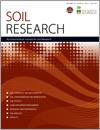SR16200Comparative effects of crop residue incorporation and inorganic potassium fertilisation on apparent potassium balance and soil potassium pools under a wheat–cotton system
Long-term continuous cropping with unbalanced fertilisation has led to the serious depletion of available soil K pools and resulted in a negative K balance. In a 3-year field experiment, crop residue incorporation and inorganic K fertilisation had similar effects on soil K pools and balance depending on initial soil K level and actual K input. Consecutive crop residue incorporation could partly replace inorganic K fertiliser to increase K release and crop K uptake, and decrease K deficit, and so decreasing K fertilisation is feasible.




